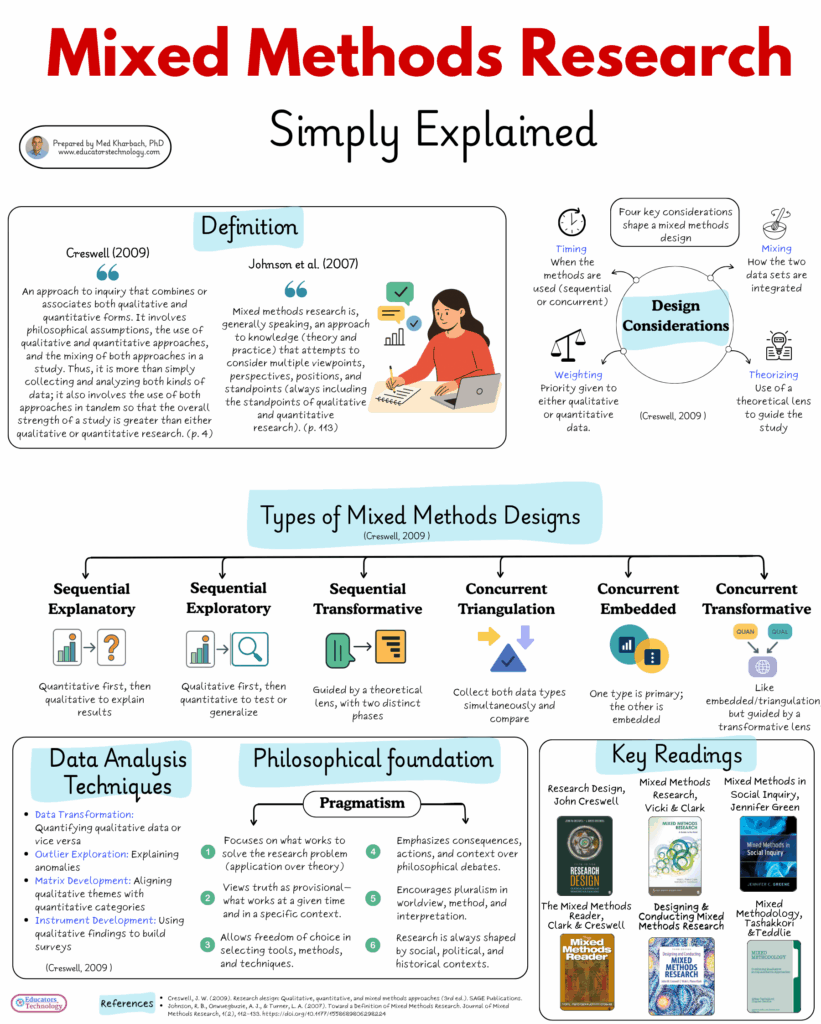In previous posts I shared here and elsewhere, I discussed both qualitative research and quantitative research and in this post, I talk about mixed methods research. I also created an illustrative visual that you can download for free at the bottom of this page.
What is Mixed Methods Research?
Creswell (2019) defines mixed methods research as
“an approach to inquiry that combines or associates both qualitative and quantitative forms. It involves philosophical assumptions, the use of qualitative and quantitative approaches, and the mixing of both approaches in a study. Thus, it is more than simply collecting and analyzing both kinds of data; it also involves the use of both approaches in tandem so that the overall strength of a study is greater than either qualitative or quantitative research.” (p. 4)
As for Johnson et al., (2007), mixed methods research is
“generally speaking, an approach to knowledge (theory and practice) that attempts to consider multiple viewpoints, perspectives, positions, and standpoints (always including the standpoints of qualitative and quantitative research).” ( p. 113)
Both definitions highlight what makes mixed methods research distinct: it’s not just about combining two types of data collection, it’s about integrating two ways of thinking. Creswell (2019) emphasizes the intentional blending of methods to enhance the overall strength of the study, while Johnson et al. (2007) bring attention to the epistemological breadth of mixed methods, showing how it encourages researchers to consider diverse perspectives and standpoints. Together, these definitions underscore the value of methodological pluralism in producing richer, more nuanced understandings of complex research questions.
2. Philosophical foundation
At the heart of mixed methods research lies a pragmatic philosophical foundation. Rather than being anchored in a single worldview, pragmatism prioritizes what works in addressing the research problem. It values flexibility, context, and practical outcomes over abstract debates. This orientation allows researchers to draw on both qualitative and quantitative tools, acknowledging the value of diverse perspectives, methods, and interpretations. In doing so, it offers a balanced and adaptable approach to understanding complex questions.
Here are some of the things that characterize the pragmatic approach in research:
- Focuses on what works to solve the research problem (application over theory).
- Emphasizes consequences, actions, and context over abstract philosophical debates.
- Prioritizes the research problem rather than the method itself.
- Supports using all available approaches—quantitative, qualitative, or both.
- Views truth as provisional—what works at a given time and in a specific context.
- Allows freedom of choice in selecting tools, methods, and techniques.
- Recognizes that research is always shaped by social, political, and historical contexts.
- Not committed to one system of reality—acknowledges both subjective and objective views.
- Encourages pluralism in worldview, method, and interpretation.
- Serves as a philosophical foundation for integrating multiple forms of data and analysis.
3. Design Considerations
Designing a mixed methods study involves more than choosing two data types, it requires thoughtful planning around how those methods interact. Four key considerations help shape this process: timing, or when each method is applied; weighting, or which type of data takes precedence; mixing, or how the data sets are brought together; and theorizing, or the use of a guiding framework. Together, these decisions define the structure and coherence of a mixed methods study.
- Timing: When the methods are used (sequential or concurrent)
- Weighting: Priority given to either qualitative or quantitative data
- Mixing: How the two data sets are integrated
- Theorizing: Use of a theoretical lens to guide the study
4. Types of Mixed Methods Designs
Mixed methods research can take different shapes depending on how and when qualitative and quantitative methods are combined. Researchers have developed several design types to structure this integration. Each type reflects a different purpose and sequence, for example, using one method to explain the other, collecting both at the same time, or grounding the entire process in a specific theoretical lens. Understanding these design types helps researchers choose the most appropriate structure for their question, context, and goals.
- Sequential Explanatory: Quantitative first, then qualitative to explain results
- Sequential Exploratory: Qualitative first, then quantitative to test or generalize
- Sequential Transformative: Guided by a theoretical lens, with two distinct phases
- Concurrent Triangulation: Collect both data types simultaneously and compare
- Concurrent Embedded: One type is primary; the other is embedded
- Concurrent Transformative: Like embedded/triangulation, but guided by a transformative lens
Key Readings
For those looking to deepen their understanding of mixed methods research, several foundational texts offer valuable guidance. These works go beyond definitions to explore design principles, philosophical foundations, and practical applications. From Creswell’s widely cited frameworks to Greene’s interpretive insights and Tashakkori and Teddlie’s early contributions, the readings below provide essential perspectives for both new and experienced researchers working with mixed methods.
- Research Design: Qualitative, Quantitative, and Mixed Methods Approaches, by John Creswell
- Mixed Methods in Social Inquiry, Jennifer Greene
- Mixed Methods Research: A Guide to the Field, by Vicki L. Plano Clark (Author), Nataliya V. Ivankova (Author)
- Designing and Conducting Mixed Methods Research, by John W. Creswell (Author), Vicki L. Plano Clark (Author)
- Mixed Methodology: Combining Qualitative and Quantitative Approaches, by Abbas Tashakkori & Charles B. Teddlie (Author)
Here is the link to download the poster below in PDF format!

References
- Creswell, J. W. (2009). Research design: Qualitative, quantitative, and mixed methods approaches (3rd ed.). SAGE Publications.
- Johnson, R. B., Onwuegbuzie, A. J., & Turner, L. A. (2007). Toward a Definition of Mixed Methods Research. Journal of Mixed Methods Research, 1(2), 112–133. https://doi.org/10.1177/1558689806298224
The post Mixed Methods Research Simply Explained appeared first on Educators Technology.